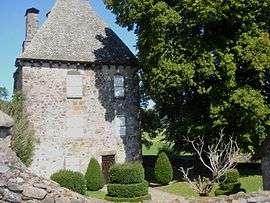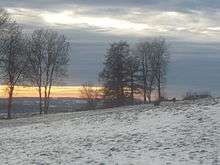Giou-de-Mamou
| Giou-de-Mamou | |
|---|---|
| Commune | |
 The Manor of Falhiès, in Giou-de-Mamou | |
 Giou-de-Mamou Location within Auvergne-Rhône-Alpes region  Giou-de-Mamou | |
| Coordinates: 44°55′58″N 2°30′53″E / 44.9328°N 2.5147°ECoordinates: 44°55′58″N 2°30′53″E / 44.9328°N 2.5147°E | |
| Country | France |
| Region | Auvergne-Rhône-Alpes |
| Department | Cantal |
| Arrondissement | Aurillac |
| Canton | Vic-sur-Cère |
| Intercommunality | CA Bassin d'Aurillac |
| Government | |
| • Mayor (2008–2014) | Gabriel Peyronnet |
| Area1 | 14.23 km2 (5.49 sq mi) |
| Population (2008)2 | 746 |
| • Density | 52/km2 (140/sq mi) |
| Time zone | UTC+1 (CET) |
| • Summer (DST) | UTC+2 (CEST) |
| INSEE/Postal code | 15074 /15130 |
| Elevation |
616–966 m (2,021–3,169 ft) (avg. 640 m or 2,100 ft) |
|
1 French Land Register data, which excludes lakes, ponds, glaciers > 1 km2 (0.386 sq mi or 247 acres) and river estuaries. 2 Population without double counting: residents of multiple communes (e.g., students and military personnel) only counted once. | |
Giou-de-Mamou is a commune in the Cantal department in south-central France.
Geography
Giou-de-Mamou is 564 km away from Paris and 6 km away from Aurillac.
The village lies at an altitude of 740 metres and is only 20 km away from the Heart of the Auvergne Volcano Park.
Language
The Occitan language was historically dominant in Cantal.
Climate
Giou de Mamou's climate is quite cold in winter (it snows almost every year), but it can be very hot during the summer times.

History
Giou-de-Mamou's rock has probably been inhabited since the Celtic period (megalithic remains have been found in the village).
The name Giou-de-Mamou is of ancient origins and would indicate that Jupiter (Jovis) was worshiped there.[1]
Prior to the French Revolution Giou de Mamou was part of a former province of Auvergne called Haute-Auvergne. Giou de Mamou joined the Aurillac district in 1990.[2]
Population
| Historical population | ||
|---|---|---|
| Year | Pop. | ±% |
| 1962 | 446 | — |
| 1968 | 427 | −4.3% |
| 1975 | 461 | +8.0% |
| 1982 | 648 | +40.6% |
| 1990 | 677 | +4.5% |
| 1999 | 697 | +3.0% |
| 2008 | 746 | +7.0% |
Sights
See also
References
- 1 2 Cantal Passion's Website - in French only Archived 2011-10-02 at the Wayback Machine.
- 1 2 Information on Giou-de-Mamou, Aurillac's District website - in French only Archived 2011-11-30 at the Wayback Machine.
| Wikimedia Commons has media related to Giou-de-Mamou. |